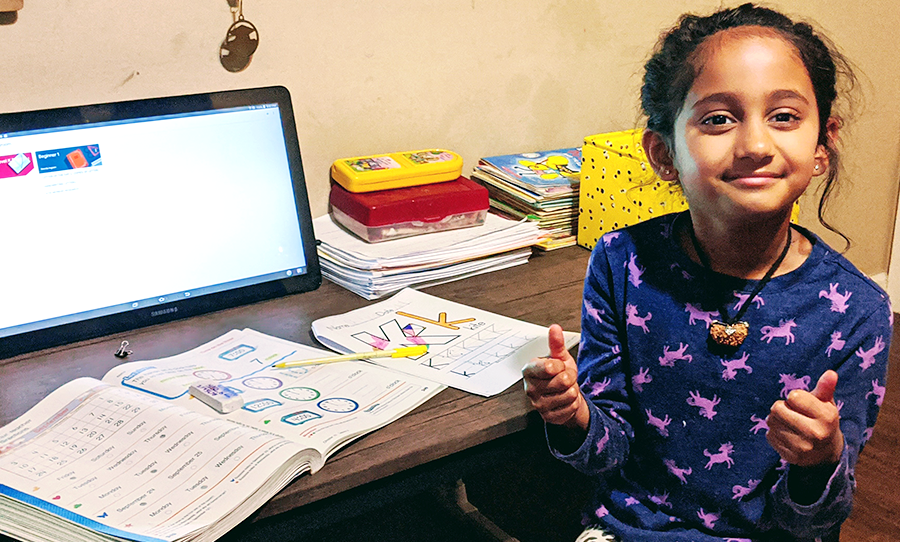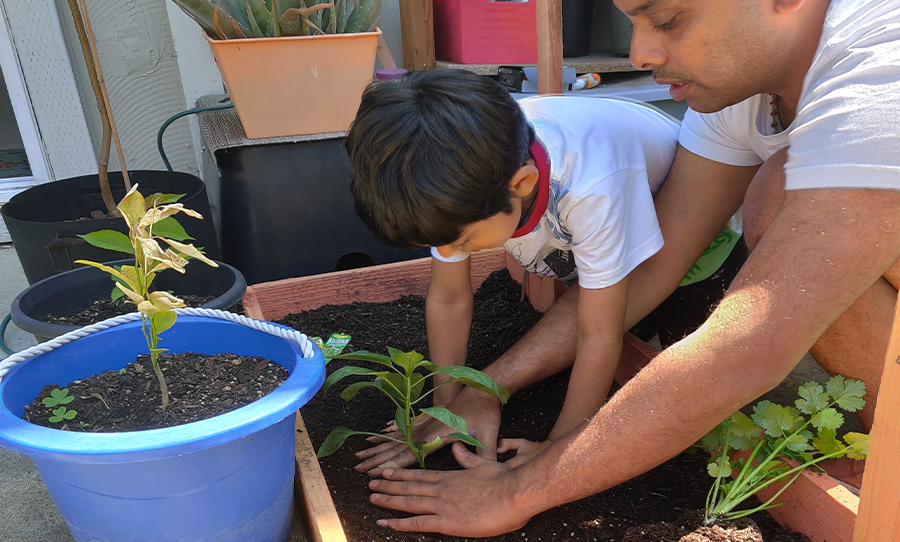9 Tips for Distance Learning Success
Across the world, students and parents are faced with distance learning. Delphi teachers have identified nine helpful tips for successful distance learning that seem common to all students.

Parents around the world are finding themselves at home with their family, trying to live, work and help educate their child through distance learning every day. A few weeks into distance learning, Delphi teachers have identified nine tips for successful distance learning that seem common to students of all ages. Check out our list and see if there are any that may help!
1. Create a dedicated learning space.
Together with your child, find a place where they can keep their materials, sit comfortably, and work without too much distraction. Providing a small table or desk and chair, good lighting, good Wifi connection, and room for their school books, materials and supplies is helpful. Consider other family members that also need to work and study. Personal study and work spaces somewhat close together can be good for parents to easily check up on and assist their child. If too close together, however, multiple phone calls and video chats going on in the same space can create a cacophony. Look over your space with your child and other family members to give each person room to work. It won't be perfect, and at times the house may feel too small, but do the best you can.

2. Help your child stay organized.
A little bit of organization can go a long way. Even with distance learning with many online components, most students still need to use textbooks, workbooks, complete math pages or worksheets, make art, etc. Some of their completed work will need to be scanned or photographed to submit, while other assignments will be done entirely online. Students will be working on multiple subjects through the day as well. Talk with your child about what organization system will work best for them. For young children, an "out box" where they can put completed work that needs scanning might be helpful. Older children should have enough physical folders or binders to track subjects that still require paper components. Do your best to keep the study and work areas of your home clean and uncluttered.
3. Take time to get familiar with the technology.
Switching to distance learning can be a steep learning curve for everyone. Set aside 15-30 minutes to watch some tutorials and to experiment with the platform(s) your school is using. When parent and student are both oriented to Google Classroom, Hangouts, Zoom, Flipgrid and other tools, it will be easier to attend live classes, to keep track of assignments and submit them successfully. The systems are not infallible, so it's inevitable that there will be some troubleshooting. Be patient with yourselves and understand that it won't always be perfect. Ask the teacher for guidance if there's anything you don't understand.

4. Don't drop the basics.
Staying at home all the time can blur the line between work and play, schooltime and vacation. The basics that you'll want your child to commit to are those things that came naturally in the days when everyone got up in the morning and went to work and school.
- Get dressed every morning. This is helpful not just for your video chat check-in and roll call, but to provide a sense of readiness for the day.
- Eat a good breakfast. Spend time together as a family in the morning to fuel up and prepare for a great day.
- Keep up personal hygiene. Shower, bathe, brush your teeth! As the long days string together, it might be tempting to skip, but students will feel better with a routine of self care.
5. Strive for a consistent schedule -- but be kind to yourself if it falls through.
There are many kinds of distance learning, but if your teacher is suggesting a particular schedule that is similar to what your child experienced when on campus, doing your best to follow it can be helpful. Older students can usually follow the suggested check-ins, live classes and personal study times on their own. Younger students, who require much more assistance from an adult, may not be able to keep up with the proposed schedule due to constraints from the parents' need to work or be otherwise occupied. If you can't make it, don't stress. Talk with your child and with your child's teacher to find the best ways to help your child be a successful distance learning student.
6. Ask for help.
Technology glitches, scheduling difficulties, distractions from the devices students need to use for distance learning -- there can be many issues that arise as families navigate distance learning. Reach out to your teacher or school administrators when you need assistance. Find out from other parents how they're handling similar difficulties. Around the country, parents and students are experiencing similar hurdles. Educators want to help you, and want to hear what you're running into as it may be common to more families. More communication at this time is better than less; we can all learn from each other.
7. Balance your day with enrichment.

Of course there are the work duties, home duties and academics that must be done each day and week. It can be easy to get caught up in these "must do" tasks and to neglect activities that nourish our creative sides, help us relax, or get our bodies active and moving. Ideally, schools will provide enrichment for your child in the form of P.E., read-aloud storytime, dance and music, live discussions, art lessons, projects, etc. Encourage your child to participate and when you can, join in yourself for a respite from the rigors of the day.
Additionally, you can make lunch time or break time into a family connection time. Turn everything off and chat with your child over a healthy lunch that they have helped prepare (even in a small way). Give each other your undivided attention for a few minutes and take a mental break from the day's to-do list. Do a short video workout together to get everyone moving and stretching. Play a game together at the end of the day or read a story.
8. Monitor distractions.
Tablets, phones and laptops can all be useful tools in distance learning, but they can also become terrible distractions. One addictive game or social media app can melt away hours of precious learning time. If your student does not need to be using a device the entire time, have a place where it is put away until it's time again for the child to connect online. Bring out dictionaries and calculators so the student doesn't need to rely on the device for these services. Keep the home rule and habit to not play on devices during study or work hours, and model this yourself. Encourage books, games and creative play rather than screen entertainment.
Some parents find it successful to limit screen play and diversions to weekends only. Work out what is best for your family. It may be difficult at first, but once new habits are formed students' minds will be spent inventing their own games and ideas rather than simply consuming entertainment. Keeping minds active will be helpful overall for academic progress.
9. Set goals and celebrate success.
Adults know they have work to accomplish for their jobs. A child distance learning at home also has a job -- to be a student and to advance and grow their own knowledge and abilities. Teachers will usually set a list of expectations and goals for the day and week, and possibly even some longer-term project goals for the month. It can be helpful to make a list each morning of what the child aims to accomplish that day so they can check each item off as they complete it. Check in periodically with your student and see how they're doing. If you have time, check the work to make sure they have understood it correctly. Ideally, teachers are able to check in daily with the student, but some children need more coaching and encouragement.
If you find your own work demands making it impossible to help your child adequately, talk to the teacher or recruit a family member to call in each day and talk to your child. They can become familiar with the work and help your child set goals and check in to see how they're doing later in the day. When goals are accomplished, acknowledge the good work done! Dinner could be a good time for each family member to share how their day went and what goals they met. Find tiny ways to celebrate and acknowledge everyone's success.
Every moment of connection with your child strengthens your relationship and makes it easier to smoothly help them with school work, chores and other responsibilities they have as a student and family member. Sheltering-in-place with limited outdoor access can be stressful at times, but distance learning and working from home can be made a little easier with some preparation, patience and communication.
Good luck!



